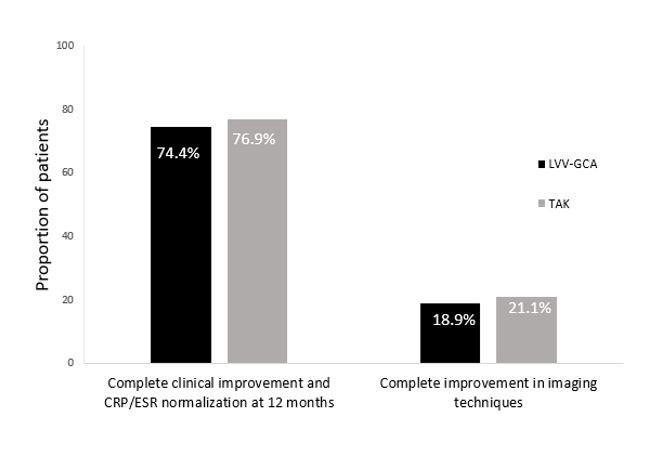Session Information
Date: Saturday, November 12, 2022
Title: Vasculitis – Non-ANCA-Associated and Related Disorders Poster I: Giant Cell Arteritis
Session Type: Poster Session A
Session Time: 1:00PM-3:00PM
Background/Purpose: Tocilizumab (TCZ) has shown to be effective for large vessel vasculitis including giant cell arteritis (GCA) and Takayasu arteritis (TAK). However, LVV-GCA and TAK show different demographic and clinical features that may influence on TCZ therapeutic response. Our aim was to compare the efficacy of TCZ in patients with LVV-GCA and patients with TAK.
Methods: Observational multicenter study of patients with LVV-GCA and TAK who received TCZ. Outcome variables were: a) proportion of patients who achieved complete clinical improvement along with normalization of laboratory markers (CRP ≤0.5mg/dL and/or ESR ≤ 20 mm/1st hour) at 12 months b) complete improvement in imaging techniques. A comparative study between patients with LVV-GCA and TAK was performed.
Results: We evaluated 70 LVV-GCA and 57 TAK patients who received TCZ. Main clinical and demographic characteristic are described in Table. Patients with TAK were younger, had longer disease duration, had received more commonly previous biologic therapy and were receiving higher doses of prednisone at baseline. TCZ intravenous administration was more common in TAK patients (80.7% vs 48.6%; p< 0.01). Follow-up time after TCZ onset was similar in both groups. At 12 months, about 75% of patients achieved complete clinical improvement and ESR/CRP normalization in both groups. A follow-up imaging technique was performed in 37 LVV-GCA patients after a mean time of 12.9±6.0 months and 38 TAK patients after 9.5±5.0 months. Complete improvement in imaging techniques was only observed in 18.9% and 21.1% of patients with LVV-GCA and TAK, respectively (figure).
Conclusion: The efficacy of TCZ was similar in patients with LVV-GCA and TAK, despite a more refractory disease in TAK patients. A discordance between clinical and imaging activity improvement was observed in both LVV-GCA and TAK, as reported in previous studies.
To cite this abstract in AMA style:
Prieto-Peña D, Loricera J, Castañeda S, Moriano C, Bernabeu P, Vela-Casampere P, Narváez F, Aldasoro V, Maíz O, Fernández-López J, Freire M, Melero R, Villa J, Gonzalez-Alvarez B, Solans-Laqué R, Callejas J, Fernandez-Diaz C, Garcia-Morillo S, Minguez M, Fernández-Carballido C, Rubio E, De Miguel E, Sánchez-Martín J, Fernandez E, Melchor S, Salgado-Pérez E, Bravo B, Romero Yuste S, Galíndez-Agirregoikoa E, Sivera f, Ferraz Amaro I, Hidalgo C, Romero Gomez C, Galisteo C, Moya Alvarado P, Alvarez-Rivas N, Mendizabal J, Nieto González J, de Dios J, Andreu J, Fernandez-Llanio N, Labrador E, Raya Álvarez E, Conesa A, Ortiz-Sanjuan F, Manrique Arija S, Rua-Figueroa I, García-valle A, González-Gay M, Blanco R. Tocilizumab in Large-Vessel Giant Cell Arteritis and Takayasu Arteritis: Multicentric Observational Comparative Study [abstract]. Arthritis Rheumatol. 2022; 74 (suppl 9). https://acrabstracts.org/abstract/tocilizumab-in-large-vessel-giant-cell-arteritis-and-takayasu-arteritis-multicentric-observational-comparative-study/. Accessed .« Back to ACR Convergence 2022
ACR Meeting Abstracts - https://acrabstracts.org/abstract/tocilizumab-in-large-vessel-giant-cell-arteritis-and-takayasu-arteritis-multicentric-observational-comparative-study/


